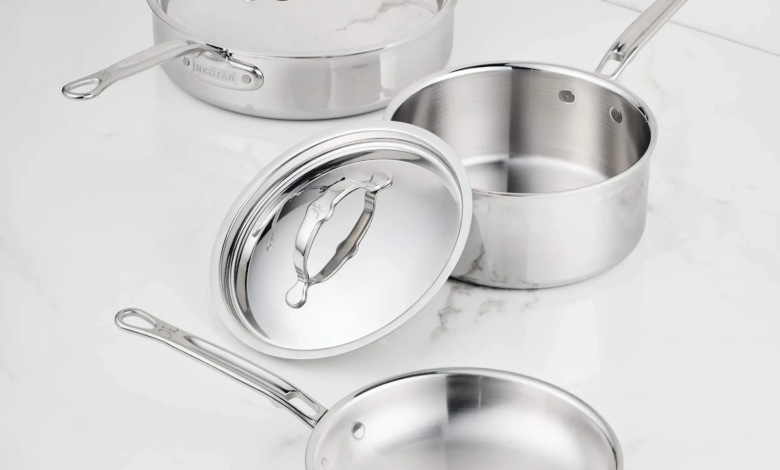Cladded Stainless Steel Pans: A Complete Guide

When it comes to cookware, stainless steel is often considered the gold standard for durability, versatility, and performance. Among the different types of stainless steel cookware, cladded stainless steel pans stand out as a popular choice for both home cooks and professional chefs. Known for their ability to combine strength with superior heat distribution, these pans are a staple in many kitchens. But what exactly is cladding, and why does it matter? Let’s explore everything you need to know about cladded stainless steel pans.
What Is a Cladded Stainless Steel Pan?
A cladded stainless steel pan is made by bonding multiple layers of metals together—typically stainless steel on the outside with a core of aluminum or copper sandwiched in between. This layered construction is referred to as “cladding.” The stainless steel provides durability, resistance to rust and staining, and a non-reactive cooking surface, while the inner layer of aluminum or copper ensures excellent heat conduction.
This combination allows the pan to deliver the best of both worlds: the toughness of stainless steel and the efficient heat distribution of conductive metals.
How Cladded Cookware Is Made
The manufacturing process involves pressing and fusing layers of different metals under high pressure and heat. The result is a permanent bond that acts as a single piece of cookware.
Common configurations include:
- 3-ply (Tri-ply): Stainless steel–aluminum–stainless steel.
- 5-ply: Stainless steel–aluminum–aluminum–aluminum–stainless steel.
- 7-ply: Multiple alternating layers for advanced heat distribution and retention.
The more layers, the more evenly the pan distributes and holds heat, though additional plies also add weight and cost.
Benefits of Cladded Stainless Steel Pans
- Even Heat Distribution
Aluminum and copper are much better conductors of heat than stainless steel. By cladding these metals inside the pan, hot spots are minimized, and cooking results are more consistent. - Durability
Stainless steel is resistant to scratches, dents, and rust. A cladded pan can withstand daily use and still maintain its shape and finish for years. - Non-Reactive Surface
Unlike pure aluminum or copper, stainless steel does not react with acidic foods like tomatoes, vinegar, or citrus. This means you can cook a wide range of dishes without altering flavors. - Versatility
Most cladded stainless steel pans are compatible with all types of stovetops, including induction. They can also go from stovetop to oven, making them ideal for searing, baking, and roasting. - Professional Quality
Many restaurants and professional chefs rely on cladded stainless steel cookware because of its consistent performance and reliability in high-demand kitchens.
Drawbacks to Consider
While cladded stainless steel pans are excellent tools, they are not without a few downsides:
- Weight: More layers make the pan heavier, which may be inconvenient for some users.
- Cost: Cladded pans are more expensive than standard stainless steel or aluminum pans due to the complex manufacturing process.
- Learning Curve: Stainless steel requires proper preheating and oiling to prevent food from sticking. Beginners may need some practice.
Common Uses in the Kitchen
Cladded stainless steel pans are highly versatile and can be used for:
- Searing meats for a golden-brown crust.
- Sautéing vegetables evenly without burning.
- Making pan sauces since the surface allows fond (caramelized bits) to form.
- Simmering soups or stews thanks to steady heat retention.
- Cooking acidic dishes like tomato-based pasta sauces without worry.
From delicate fish fillets to hearty one-pan meals, these pans handle almost any task.
Caring for Your Cladded Stainless Steel Pan
To ensure your cookware lasts for decades, proper care is important:
- Preheat before cooking: This reduces sticking and improves results.
- Use the right utensils: Stainless steel is tough, but using wooden, silicone, or plastic utensils helps preserve the cooking surface.
- Avoid high heat: Medium heat is often sufficient because of the pan’s efficiency.
- Hand wash when possible: While many are dishwasher safe, hand washing with warm water and mild soap maintains the finish longer.
- Remove discoloration: A paste of baking soda and water can restore shine if the pan develops heat stains.
With proper maintenance, a cladded stainless steel pan can become a lifelong kitchen companion.
See also: The Future of Car Air Conditioning: Eco-Friendly and Energy-Efficient Cooling Technologies
What to Look for When Buying
Not all cladded cookware is created equal. When shopping for a pan, consider the following:
- Number of Layers (Ply): More layers generally mean better heat control, but also more weight and expense.
- Core Material: Aluminum is common and affordable, while copper offers superior conduction but at a higher price.
- Weight and Balance: Choose a pan that feels sturdy but manageable in your hand.
- Handle Design: Riveted stainless steel handles are durable and usually stay cool on the stovetop.
- Oven Safety: Check the maximum oven-safe temperature if you plan to use it for roasting or baking.
- Brand Reputation and Warranty: Established brands often provide better quality and long-term support.
Comparing Cladded Stainless Steel to Other Cookware
- Versus Nonstick Pans: Nonstick pans are easier to clean and better for delicate foods like eggs, but they wear out faster and cannot withstand high heat as well.
- Versus Cast Iron: Cast iron excels at heat retention and browning but is heavier, requires seasoning, and is reactive with acidic foods.
- Versus Carbon Steel: Similar to cast iron but lighter, carbon steel also needs seasoning and more care than stainless steel.
In comparison, cladded stainless steel offers a balanced approach—combining durability, versatility, and reliable heat performance.
Who Should Buy a Cladded Stainless Steel Pan?
Cladded stainless steel pans are ideal for:
- Home cooks who want one all-purpose, long-lasting pan.
- Culinary enthusiasts seeking professional-quality cookware.
- Anyone who cooks a variety of dishes, from searing meats to simmering sauces.
- People looking for a pan that can transition from stovetop to oven seamlessly.
They may not be necessary for those who rarely cook or only prepare simple meals, but for frequent and diverse cooking, they are an excellent investment.
Conclusion
Cladded stainless steel pans represent a perfect marriage of durability and performance. By fusing stainless steel with conductive metals like aluminum or copper, these pans provide the reliability of stainless steel along with the cooking efficiency of more heat-responsive materials. Though they may come with a higher price tag and a bit of a learning curve, their longevity, versatility, and professional quality make them a smart choice for anyone serious about cooking.
Whether you’re a beginner setting up your first kitchen or an experienced chef upgrading your tools, a cladded stainless steel pan is a piece of cookware that can serve you well for decades. Investing in one is less about buying another pan and more about adding a dependable partner to your cooking journey.







